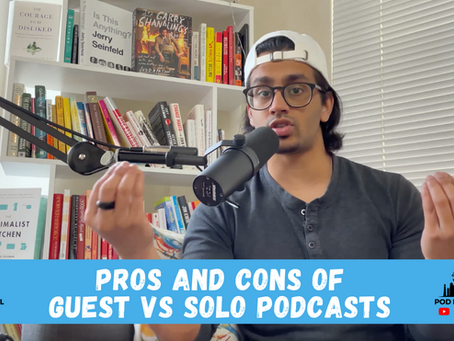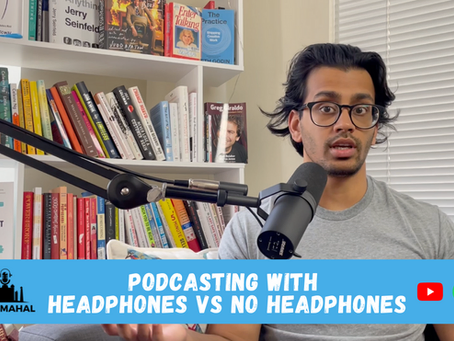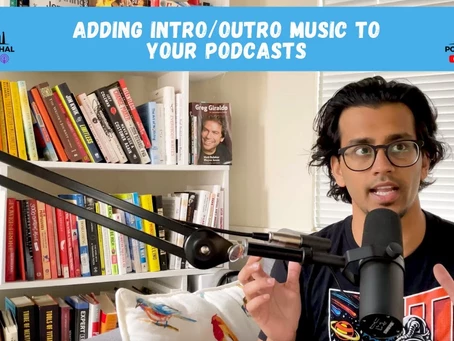Podcast production can be a nightmare when you don’t have your storage in check. I’ve recorded tons of episodes on my friend’s phone that would regularly run out while we were shooting. Let’s talk about using Google Drive vs External Hard Drives to back up your work so publishing is a breeze.
Bite-sized action items to go from dreaming to streaming your podcast.
Podcast Transcript:
Hey friends. Welcome back to Padmahal. My name is Misbah Haque and today I want to talk to you a little bit about backup storage, how to keep your files organized, for podcasting. You’re going to need someplace where you have like an archive of all the different little, audio files that you have. You know, the projects that you have in your video editor, your sound editor. Even if it’s just passing it off to somebody for post-production. Having those files in an organized place and being able to identify them and somebody else being able to identify them makes this whole process very smooth before we do that. Make sure you like, and subscribe really helps support the show and keeps me putting out a lot of free, awesome content for you that hopefully helps.
So, um, make sure you subscribe, if you haven’t already, wherever you’re listening or watching.
Bigger SD Card or Smaller One!
Now let’s dive in. So the external hard drive that I go with is the WD a Y it’s like the two terabytes one. I have two of these. The other one I think is like one terabyte or something like that. I definitely recommend getting something that’s at least two terabytes. Especially now with the kind of, high-quality videos and audio that you’re shooting. It takes up a lot of memory and it’s nice to have a place where you can back that stuff up. The benefit of having an external hard drive is you now have a place to put additional things too. So a client of mine was like, oh, if I noticed that in the zoom H six, which is the recorder for. Doing in-person podcasts, he’s like, you can just put an SD card. What if I get a bigger SD card?
Do I really need an external hard drive at that point? If I could just keep the files there. And my answer to that was like, you could pull that off, but it’s nice to have this because all sorts of files can go on here and it doesn’t mess with the kind of like you keep things separate for separate tasks, right? So I would say in podcasting, your external hard drive really becomes a kind of like your lifeline because it keeps your computer running fast. So that’s probably the biggest advantage is you can very easily drag and drop. And save a lot of different things in here. You have a separate section for your intro music, your outro music. You have the raw files for the audio.
Dropbox or Google Drive!
You have raw files for the video. Then you have the final files for the audio final files for, uh, the audio, right?
So these different components, the album artwork, that’s something you’re going to have to keep hitting over and over every time you upload an episode, so might as well have that in an accessible place. And this is a great way to do that. Now the Google drive, I will say, or Dropbox, I use Dropbox too. I will say I like Google drive better because of how it fits into the workflow of everything else that I do. I use a lot of Google docs and sheets and things like that. So, uh, having just an extra folder that’s for the podcast and has the same breakdown that I mentioned keeps it easier. When I work with clients, I use Google drive anyways, in terms of them sharing files with me back and forth. So it’s just an additional place that you can keep your files backed up too.
Being a Paranoid.
I like to have, and maybe I just have OCD about losing stuff, right. But I like to have a backup version. That’s actually on a physical hard drive as well. The Google drive, though, what the advantage there is, I think for like 1 99 a month, you get 20 terabytes of cloud storage. But again, keep in mind it’s it’s the cloud, right? So, uh, not that I’m overly paranoid, like, oh, this, this is up in the cloud and now, you know, uh, it can never be deleted or whatever. I’m sure some of that is true, but it’s like with what you’re going to be putting out, it’s probably not a big deal. If you are a little bit paranoid about that though, you know, having, uh, an external hard drive eliminates that a little bit.
Now the Google drive, I recommend getting the extra storage because, in terms of sharing with people, it’s the end way that you’re probably going to do it, or we transfer is another awesome tool that you can use, but in terms of actually backing up different things for your business and for your podcast, Google drive is very efficient in terms of workflow.
Keep where you can get it easily.
Now I will say that I don’t feel comfortable taking all of everything that’s on my computer. And just like putting it all on Google drive that feels like it could be a waste of space and just make it too crowded. So I do like the fact that this thing can have like all the other stuff. You know, I had a computer before this, for example. And I backed up all the pictures and documents or whatever it was that I wanted to keep. And I have a folder in the hard drive that says, backup from old Mac book and then the date. Six up a Bubba. And so now if I need to, I can go in there, but I’ve never really have had to access it. I don’t want it just sitting there and taking up space in my drive.
So I don’t know. I am a big believer in external hard drives something to be wary of though. And I didn’t know this about external hard drives. I learned this from a videographer friend of mine named Gita Larson. She’s amazing. Check out her work. Uh, quality is insane, very cinema, like she had one of those hard drives that were literally a brick. Like I’m not even kidding you like this big, right. And had even a switch to like turn it on and off. I was like, this thing is really intense. Mine’s kind of just plug and play. Do you know what I mean? It’s like one of those clip-on ties versus having to do the loop.
Investment is worth for.
So this thing that she had was really cool, but she said. Even with these types of hard drivers, it’s not uncommon for them to sometimes crash or like. You know, accidentally get wiped out or something weird like that.
Um, there are ways to recover it and to if that happens to you, but that’s why going with reputable brands like, you know, WD or whatever other ones you prefer is a smart idea. Um, and not skimping out because it’s something you’re going to use for a long time, not just for podcasts. So my take is, if it’s in your budget, go ahead and grab one. You can definitely get something good. I would say between 80 to $120 or so, it varies the more storage you want, obviously the more expensive it will be. And it depends on the brand, but it’s a worthwhile investment.
Or you can keep it in two places.
If you can swing it and Google drive as well is worth it. If you can swing it, um, if you don’t mind going the extra step to back it up in two different places, that is a very secure way to go.
If you’re like me, hopefully, this video helped you choose which one you’d rather go with for now. Um, you know, if it is Google drive for just getting started and for the sake of efficiency do it, you can always download that stuff later and back it up to a hard drive. Eventually, if you know, when your budget allows for it, or you decide to just go that route. So hope this was helpful. Thank you so much for watching. Make sure you like and subscribe. If you enjoy the video, uh, check out Mizhq.com for a ton of free resources, um, reach out if you have any questions at all. But yeah, my name is Misbah Haque. Thank you for watching and listening and I’ll see, see you next time.



